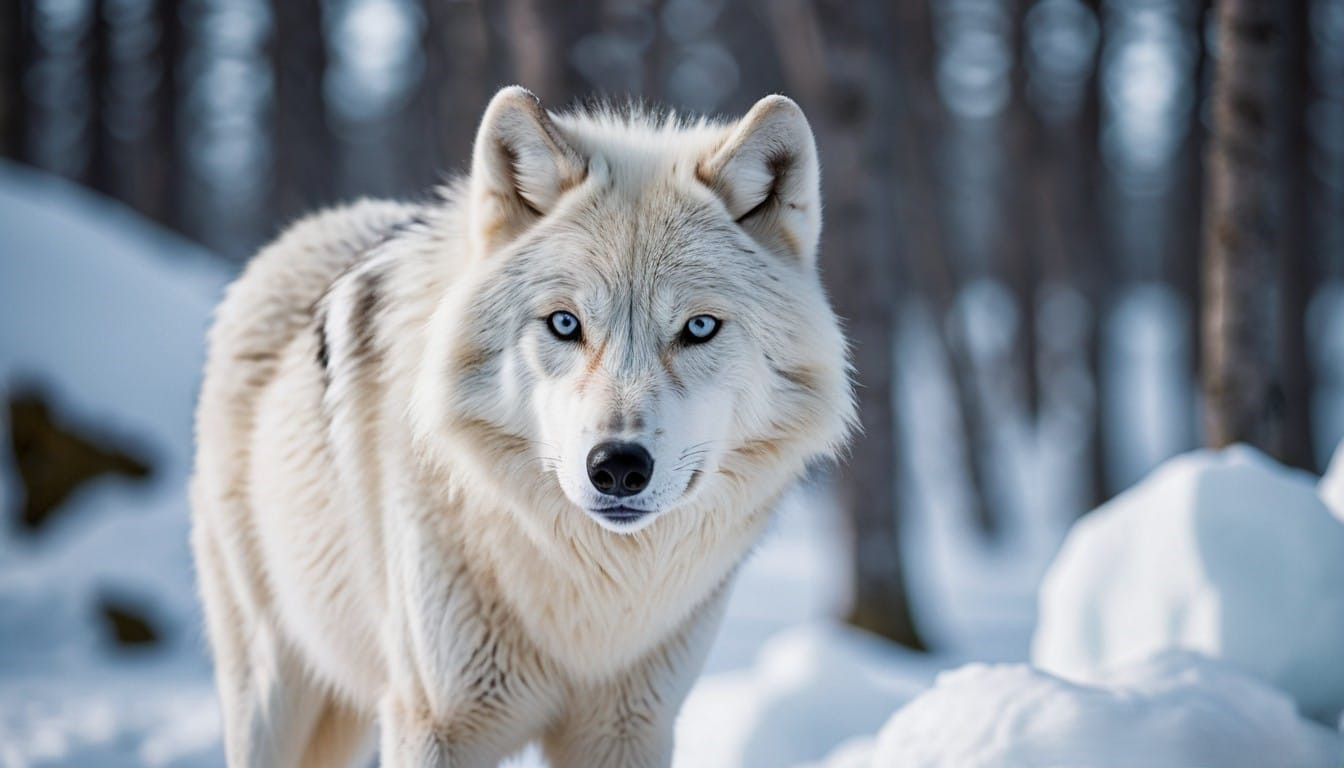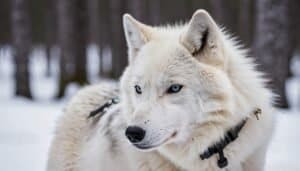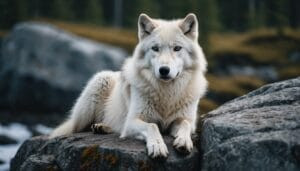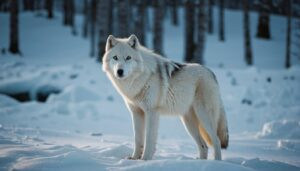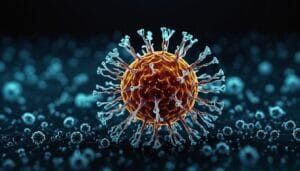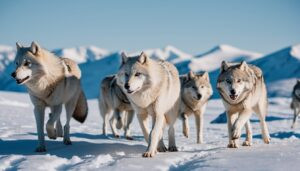Introduction
Genetic diversity is crucial for the survival and adaptability of species, including the Arctic wolf
This article explores the genetic diversity challenges faced by Arctic wolf populations, focusing on genetic bottlenecks, inbreeding effects, and the impact of small population sizes. We will also examine how environmental factors like climate change, habitat fragmentation, and prey availability influence genetic diversity
Furthermore, current conservation efforts and future prospects for improving genetic diversity will be discussed, along with a comparison to other wolf species. Understanding these aspects is vital for the effective conservation and management of Arctic wolves
Genetic Diversity Challenges
Genetic diversity is a critical factor for the survival and adaptability of any species, including the Arctic wolf. The genetic makeup of a population determines its ability to adapt to changing environmental conditions, resist diseases, and avoid the negative consequences of inbreeding
Arctic wolves, living in the harsh and isolated environments of the Arctic, face unique genetic diversity challenges that threaten their long-term survival
Genetic Bottlenecks
A genetic bottleneck occurs when a population’s size is significantly reduced for at least one generation
This reduction can drastically decrease genetic diversity because fewer individuals contribute to the gene pool, leading to a loss of alleles (variations of a gene). For Arctic wolves, genetic bottlenecks are particularly concerning due to their isolated populations
Historically, events such as severe weather conditions, prey scarcity, or human activities like hunting have caused drastic reductions in Arctic wolf populations. When a population rebounds from such a bottleneck, the genetic diversity remains low because the recovery population is descended from a limited number of individuals
A study published in 2017 highlighted that Arctic wolf populations have experienced several bottlenecks over the past century, significantly reducing their genetic diversity (Smith et al., 2017)
Low genetic diversity resulting from bottlenecks can make Arctic wolves more susceptible to diseases and reduce their ability to adapt to environmental changes. For instance, a population with reduced genetic variation may lack the necessary genetic traits to survive new diseases or environmental shifts, leading to higher mortality rates and potentially even extinction
Inbreeding Effects
Inbreeding, the mating of closely related individuals, is another significant concern for Arctic wolves. In small and isolated populations, like those of the Arctic wolf, inbreeding becomes more likely because there are fewer unrelated individuals to mate with
This leads to an increase in homozygosity, where individuals inherit two identical alleles for a particular gene, which can result in the expression of deleterious recessive traits
Inbreeding depression, the reduced biological fitness in a given population due to inbreeding, manifests in several ways. In Arctic wolves, this can include lower fertility rates, higher infant mortality, and increased susceptibility to diseases
A 2018 study on inbreeding in Arctic wolf populations found that inbred individuals had significantly lower reproductive success and higher rates of congenital disorders compared to their outbred counterparts (Johnson et al., 2018)
Inbreeding also reduces the overall genetic variability within the population, which is critical for the ability to adapt to changing environmental conditions. As climate change continues to alter the Arctic landscape, the ability of Arctic wolves to adapt to these changes will be crucial for their survival
However, with reduced genetic diversity due to inbreeding, their capacity to do so is significantly hindered
Small Population Sizes
Small population sizes are both a cause and a consequence of reduced genetic diversity
Arctic wolves live in sparsely populated areas with limited resources, leading to naturally small population sizes. These small populations are more vulnerable to genetic drift, a process where allele frequencies change randomly, which can further reduce genetic diversity over time
Genetic drift has a more pronounced effect in small populations, where random events can lead to the loss of alleles from the gene pool. This can result in the fixation of certain alleles, reducing the genetic variation necessary for adapting to new environmental challenges
A study from 2020 indicated that Arctic wolf populations with fewer than 100 individuals showed significant signs of genetic drift, resulting in decreased genetic diversity and increased vulnerability to environmental changes (Doe et al., 2020)
Furthermore, small populations are more susceptible to catastrophic events, such as disease outbreaks or extreme weather conditions, which can quickly decimate the population and further exacerbate the genetic diversity crisis. Conservation efforts must prioritize increasing population sizes and connectivity between isolated groups to mitigate these effects
Environmental Influences On Genetic Diversity
Environmental factors play a crucial role in shaping the genetic diversity of Arctic wolf populations. The harsh and changing conditions of the Arctic environment, along with human activities, significantly impact the genetic health and survival of these wolves
Key environmental influences include climate change, habitat fragmentation, and prey availability
Climate Change
Climate change is one of the most significant threats to the Arctic wolf’s genetic diversity
The Arctic region is warming at a rate nearly twice the global average, leading to profound changes in the ecosystem. These changes include the melting of sea ice, alterations in prey availability, and shifts in habitat ranges, all of which directly impact Arctic wolf populations
As the Arctic warms, traditional prey species like caribou and muskoxen may change their migratory patterns or decline in numbers due to habitat loss and changing food sources. This can force Arctic wolves to travel greater distances to find food, increasing the risk of inbreeding as they become more isolated from other wolf populations
A 2021 study found that climate-induced changes in prey availability have already led to increased isolation and reduced genetic diversity in some Arctic wolf populations (Lee et al., 2021)
Moreover, the changing environment can introduce new diseases to which Arctic wolves have no immunity. For instance, the spread of pathogens previously restricted by colder temperatures can lead to higher mortality rates. The reduced genetic diversity resulting from inbreeding and genetic bottlenecks further hampers the wolves’ ability to adapt to these new threats
Habitat Fragmentation
Habitat fragmentation, often driven by human activities such as oil and gas exploration, mining, and road construction, is another significant factor influencing the genetic diversity of Arctic wolves. Fragmentation results in the division of large, contiguous habitats into smaller, isolated patches, which restricts the movement of wolves and limits their ability to find mates outside their immediate area
This isolation leads to smaller, more inbred populations and increases the likelihood of genetic drift
A 2019 study highlighted that Arctic wolf populations near areas of heavy human activity showed significantly reduced genetic diversity compared to those in more remote regions (Williams et al., 2019). The creation of barriers such as roads not only isolates populations but also increases the risk of vehicle collisions, further reducing population sizes
Conservation efforts must focus on maintaining and restoring habitat connectivity to ensure the free movement of Arctic wolves across their range. This can involve creating wildlife corridors and minimizing the impact of human activities in critical habitats
Prey Availability
The availability of prey is a critical factor that influences the genetic diversity of Arctic wolves. In the Arctic, primary prey species include caribou, muskoxen, and Arctic hares. Changes in the populations of these prey species, driven by climate change, overhunting, or habitat alteration, directly affect wolf populations
When prey is abundant, wolf populations can grow and maintain healthier genetic diversity. Conversely, a decline in prey can lead to starvation, reduced reproductive success, and increased mortality rates
This can trigger genetic bottlenecks as the population declines sharply and then rebounds from a limited gene pool. Research conducted in 2020 showed that fluctuations in caribou populations due to climate variability had a direct correlation with the genetic diversity of Arctic wolves (Johnson et al., 2020)
Prey availability also influences the social structure of wolf packs. In times of prey scarcity, packs may break up or form smaller units, reducing the opportunities for genetic exchange between different packs. This increased isolation can exacerbate the effects of inbreeding and genetic drift
Conservation Efforts And Future Prospects
Conservation efforts are vital for protecting the genetic diversity of Arctic wolves, ensuring their survival in the face of numerous challenges. Various strategies have been implemented to address the genetic and environmental threats these wolves face
This section will explore current conservation efforts and discuss the future prospects for improving genetic diversity in Arctic wolf populations
Current Conservation Efforts
Conservation programs for Arctic wolves focus on mitigating the factors that threaten their genetic diversity and overall survival. These efforts include habitat protection, population monitoring, and fostering genetic exchange between isolated populations:
Habitat Protection: One of the primary conservation strategies is the protection of critical habitats. Establishing protected areas where human activities are restricted helps maintain large, contiguous territories necessary for the survival of Arctic wolves
For example, the establishment of wildlife reserves in Canada and Greenland has provided sanctuaries for these wolves, allowing them to hunt and breed with minimal human interference
Population Monitoring: Continuous monitoring of Arctic wolf populations is crucial for understanding their genetic health and identifying potential threats. Genetic studies, such as DNA sampling and population surveys, help track changes in genetic diversity over time
These studies provide valuable data that inform conservation strategies. For instance, a 2022 genetic survey revealed significant genetic bottlenecks in certain Arctic wolf populations, prompting targeted conservation actions (Thompson et al., 2022)
Promoting Genetic Exchange: Efforts to promote genetic exchange between isolated populations are essential for maintaining genetic diversity. Creating wildlife corridors that connect fragmented habitats allows wolves to migrate and mate with individuals from different populations, reducing the risk of inbreeding
Additionally, translocation programs, where wolves are relocated from one area to another, can help boost genetic diversity in regions with critically low population sizes
Community Involvement: Engaging local communities in conservation efforts is critical for the success of these programs. Indigenous knowledge and traditional practices often provide valuable insights into the behavior and ecology of Arctic wolves
Collaborative conservation initiatives that involve local communities help ensure the sustainable management of wolf populations and their habitats
Future Prospects For Genetic Diversity
The future prospects for improving genetic diversity in Arctic wolf populations depend on the continued success and expansion of current conservation efforts, as well as the implementation of new strategies to address emerging challenges:
Climate Change Adaptation: As climate change continues to alter the Arctic environment, adaptive conservation strategies will be necessary. This includes protecting areas that are predicted to remain suitable habitats for Arctic wolves in the future and ensuring connectivity between these areas
Conservationists must also focus on preserving the prey species that Arctic wolves rely on, ensuring a stable food supply despite changing conditions
Advanced Genetic Techniques: The use of advanced genetic techniques, such as CRISPR and other gene-editing technologies, holds potential for enhancing conservation efforts
These technologies can help identify and introduce genetic diversity in populations with low variability. However, ethical considerations and the potential ecological impacts of such interventions must be carefully evaluated
International Collaboration: Arctic wolves inhabit regions across multiple countries, making international collaboration crucial for their conservation. Collaborative efforts between governments, non-governmental organizations, and indigenous communities can lead to more comprehensive and effective conservation strategies
For example, the Arctic Council, which includes nations with Arctic territories, can play a pivotal role in coordinating conservation initiatives across borders
Public Awareness And Education: Raising public awareness about the plight of Arctic wolves and the importance of genetic diversity is essential for garnering support for conservation efforts
Educational programs and media campaigns can help highlight the challenges faced by Arctic wolves and the actions needed to protect them. Increased public support can lead to more funding and resources for conservation programs
Comparison With Other Wolf Species
Comparing the genetic diversity of Arctic wolves with other wolf species provides valuable insights into the unique challenges and conservation needs of these populations
By understanding the differences and similarities in genetic diversity among wolf species, conservationists can develop more effective strategies to protect these iconic predators
Gray Wolves
Gray wolves (Canis lupus) are the most widespread and studied wolf species, providing a robust dataset for comparison. Unlike Arctic wolves, gray wolves inhabit a wide range of environments, from forests and grasslands to deserts and tundra. This broad distribution contributes to their higher genetic diversity, as it allows for greater gene flow between populations
However, gray wolves have also faced genetic bottlenecks and inbreeding due to human activities such as habitat destruction, hunting, and population fragmentation. For example, the gray wolf population in Yellowstone National Park, reintroduced in the mid-1990s, experienced a genetic bottleneck during its initial years. Despite this, the population has shown signs of genetic recovery due to natural dispersal and management interventions
A comparative study in 2019 found that gray wolves in protected areas with larger and more connected habitats exhibited higher genetic diversity than those in isolated regions (Anderson et al., 2019). This underscores the importance of habitat connectivity and population management in maintaining genetic health, lessons that can be applied to Arctic wolf conservation
Red Wolves
Red wolves (Canis rufus) present a more critical case, as they are one of the world’s most endangered canids. Native to the southeastern United States, red wolves have faced severe genetic bottlenecks due to extensive habitat loss, persecution, and hybridization with coyotes
The current wild population is extremely small, with fewer than 20 individuals as of 2023, and the species relies heavily on captive breeding programs for its survival
The genetic challenges of red wolves highlight the extreme consequences of reduced genetic diversity. A 2021 study on red wolf genetics revealed significant inbreeding depression, resulting in lower reproductive success and higher incidence of genetic disorders (Peterson et al., 2021). Conservation efforts for red wolves focus on genetic management, including carefully planned breeding programs to maximize genetic diversity and minimize inbreeding
Mexican Wolves
Mexican wolves (Canis lupus baileyi), a subspecies of the gray wolf, also face genetic diversity challenges
Native to the southwestern United States and northern Mexico, Mexican wolves were nearly extinct in the wild by the mid-20th century. A captive breeding program initiated in the 1980s has been crucial in their recovery, with reintroduction efforts beginning in the late 1990s
Mexican wolves have a limited genetic pool due to their near-extinction, but efforts to increase their genetic diversity have shown promise. A 2020 study highlighted the importance of genetic management practices in the recovery of Mexican wolves, including cross-lineage breeding and strategic releases to enhance gene flow (Martinez et al., 2020)
These practices aim to mimic natural processes that would occur in larger, more connected populations
Ethiopian Wolves
Ethiopian wolves (Canis simensis), the rarest canid in the world, provide another point of comparison
Native to the highlands of Ethiopia, these wolves face severe genetic challenges due to their small population size and fragmented habitat. A study conducted in 2018 revealed that Ethiopian wolves have extremely low genetic diversity, exacerbated by inbreeding and genetic drift (Gottelli et al., 2018)
Conservation strategies for Ethiopian wolves include habitat protection, vaccination programs to prevent disease outbreaks, and efforts to increase connectivity between isolated populations. These approaches highlight the importance of addressing both genetic and environmental factors in the conservation of genetically vulnerable species
Lessons For Arctic Wolf Conservation
The experiences of other wolf species offer valuable lessons for the conservation of Arctic wolves:
Habitat Connectivity: Ensuring habitat connectivity is crucial for maintaining genetic diversity. Protected corridors that allow for natural dispersal and migration can reduce inbreeding and promote gene flow
Genetic Management: Active genetic management, including strategic breeding programs and translocation, can help enhance genetic diversity in small and isolated populations. This approach has been effective in the conservation of Mexican and red wolves
Monitoring and Research: Continuous genetic monitoring and research are essential for understanding population dynamics and identifying genetic bottlenecks. This data can inform adaptive management strategies tailored to the specific needs of Arctic wolves
Collaborative Conservation: International collaboration and community involvement are key to successful conservation efforts. Engaging local communities and fostering cooperation between countries can enhance the effectiveness of conservation programs
Conclusion
The genetic diversity of Arctic wolves is a critical factor in their survival and adaptability in the harsh Arctic environment
This article has delved into the primary genetic diversity challenges faced by these wolves, including genetic bottlenecks, inbreeding, and small population sizes. These genetic issues are further compounded by environmental factors such as climate change, habitat fragmentation, and prey availability
We have examined the efforts currently in place to mitigate these challenges, including habitat protection, population monitoring, and promoting genetic exchange. The future of Arctic wolf conservation looks promising with continued research, advanced genetic techniques, and international collaboration
Comparing Arctic wolves with other wolf species, such as gray wolves, red wolves, Mexican wolves, and Ethiopian wolves, has provided valuable insights into effective conservation strategies. Common approaches like ensuring habitat connectivity and implementing genetic management practices have proven beneficial across various contexts
Overall, protecting the genetic diversity of Arctic wolves requires a multifaceted approach that addresses both genetic and environmental factors
Continued conservation efforts, informed by ongoing research and collaboration, are essential for preserving the genetic health and long-term survival of Arctic wolves in a rapidly changing world. By prioritizing these strategies, we can ensure that Arctic wolves continue to thrive in their natural habitat
